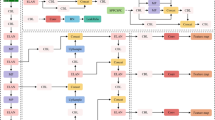Abstract
Mask R-CNN network based on deep learning algorithm is specifically optimized for the small visual defects of gears. After comparison, the ResNet-101 residual neural network is used as the image sharing feature for network extraction. Subsequently, the unreasonable convolution of the feature extraction process \({P}_{5}\) in the characteristic pyramid network is removed to improve the defect detection rate indicator. Finally, the sizes of the anchor and label frames are adjusted according to the dimensioning of the tiny objects in the capacitance sample, and an appropriate aspect ratio is set to achieve the effective training of the network in the candidate area. Experiments show that the optimized Mask R-CNN network can achieve a defect detection rate that is above 98%.












Similar content being viewed by others
Data availability
Not applicable.
Code availability
Not applicable.
Change history
27 March 2024
This article has been retracted. Please see the Retraction Notice for more detail: https://doi.org/10.1007/s10878-024-01130-0
References
Akram MW, Li G, Jin Y et al (2019) CNN based automatic detection of photovoltaic cell defects in electroluminescence images. Energy 189:116319
Jing JF, Ma H, Zhang HH (2019) Automatic fabric defect detection using a deep convolutional neural network. Color Technol 135(3):213–223
Kang Z, Yuan C, Yang Q (2013) The fabric defect detection technology based on wavelet transform and neural network convergence. In: 2013 IEEE International Conference on Information and Automation (ICIA). IEEE, pp 597–601
Krummenacher G, Ong CS, Koller S et al (2018) Wheel defect detection with machine learning. IEEE Trans Intell Transp Syst 19(4):1176–1187
Le VK, Chen Z, Wong YW et al (2020) A complete online-SVM pipeline for case-based reasoning system: a study on pipe defect detection system. Soft Comput 24(22):16917–16933
Li Y, Zhao W, Pan J (2017) Deformable patterned fabric defect detection with fisher criterion-based deep learning. IEEE Trans Autom Sci Eng 14(2):1256–1264
Liu Z, Liu X, Li C et al (2018) Fabric defect detection based on faster R-CNN. In: Ninth International Conference on Graphic and Image Processing (ICGIP 2017), vol 10615. International Society for Optics and Photonics, p 106150A
Luo Q, Gao B, Woo WL et al (2019) Temporal and spatial deep learning network for infrared thermal defect detection. NDT and E Int 108:102164
Nturambirwe JFI, Opara UL (2020) Machine learning applications to non-destructive defect detection in horticultural products. Biosyst Eng 189:60–83
Prappacher N, Bullmann M, Bohn G et al (2020) Defect detection on rolling element surface scans using neural image segmentation. Appl Sci 10(9):3290
Sassi P, Tripicchio P, Avizzano CA (2019) A smart monitoring system for automatic welding defect detection. IEEE Trans Ind Electron 66:9641–9650
Seker A, Yüksek AG (2017) Stacked autoencoder method for fabric defect detection. Cumhuriyet Sci J 38(2):342–342
Silvén O, Niskanen M, Kauppinen H (2003) Wood inspection with non-supervised clustering. Mach vis Appl 13(5–6):275–285
Sun J, Li C, Wu X et al (2019) An effective method of weld defect detection and classification based on machine vision. IEEE Trans Ind Inform 15:6322–6333
Funding
This study was supported by scientific research foundation of Nanjing Vocational University of Industry Technology (YK18-03-03) and the Natural Science Foundation of the Jiangsu Higher Education Institutions of China (20KJB410005).
Author information
Authors and Affiliations
Corresponding author
Ethics declarations
Conflict of interest
There is no conflict of interest among the authors.
Informed consent
Not applicable.
Ethical approval
This article does not contain any studies with human participants performed by any of the authors.
Additional information
Publisher's Note
Springer Nature remains neutral with regard to jurisdictional claims in published maps and institutional affiliations.
This article has been retracted. Please see the retraction notice for more detail: https://doi.org/10.1007/s10878-024-01130-0
Rights and permissions
Springer Nature or its licensor (e.g. a society or other partner) holds exclusive rights to this article under a publishing agreement with the author(s) or other rightsholder(s); author self-archiving of the accepted manuscript version of this article is solely governed by the terms of such publishing agreement and applicable law.
About this article
Cite this article
Cheng, C., Dai, N., Huang, J. et al. RETRACTED ARTICLE: Capacitance pin defect detection based on deep learning. J Comb Optim 44, 3477–3494 (2022). https://doi.org/10.1007/s10878-022-00904-8
Accepted:
Published:
Issue Date:
DOI: https://doi.org/10.1007/s10878-022-00904-8




